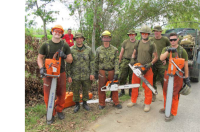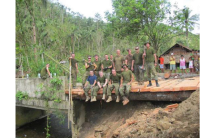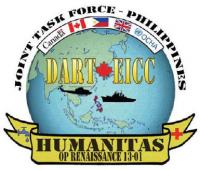Co-authored by: Sgt Pascal Johanny and Major Ryan Gregg
A multitude of countries scrambled to help the Philippines after Typhoon Yulanda (Haiyan), the most powerful storm to make landfall in recorder history, swept through its center. The storm caused major damages to infrastructure and claimed the lives of over 6000 people. Canada answered the call and deployed the Disaster Assistance Reconnaissance Team (DART) on 12 Nov 13 as Joint Task Force (JTF) Philippines. The Engineer component of JTF Philippines was made up of engineers of various trades and from units across Canada. 4 Engineer Support Regiment in Gagetown provided the bulk of the Engineers for the deployment but there were also engineers from 1st Canadian Division HQ, 2 Combat Engineer Regiment and CFB Comox. The Engineer element contained all those engineer capabilities that were planned in CONPLAN RENAISSANCE; A Headquarters, a geomatics support team, combat engineers, heavy equipment, water supply and construction engineers. All of these capabilities provided the DART with a very balanced, capable, and highly effective level of Engineer support.
Immediately upon arrival to Panay Island the engineers and their essential equipment were loaded onto Philippines’ Armed Forces (PAF) vehicles and departed the Iloilo airport, bound for their new home in the Roxas City stadium. No one was completely ready for the monumental amount of destruction that was to be encountered throughout the country.
“As soon as we left the city limits the scale of damage was assessed as overwhelming. It quickly became apparent that we would have a lot of good work to do to help the local establish their lives. The convoy took 7 hours to complete just 250 km,, progress was slowed by low hanging wires and very badly damaged roads; putting everything into perspective as we now understood that our help was really needed. We arrived at the stadium late in the evening and hit the ground running. The Roxas City stadium was going to be our home and staging area for the next month.”
– Sgt P. Johanny, Field Engr Sect Comd
The next day orders were issued and tasks were given out. In the typical engineer fashion of being “first in, last out”, all of the engineers knew right away that they were going to be busy from the very beginning until the very end.
Construction Section
The Construction section, commanded by Sgt Scott Alberts, was comprised of the various construction trades; electricians, plumbers, carpenters and more. Overall they faced the tasks of improve the living conditions within the stadium while also providing emergency construction assistance to the affected population. Across the area of operations the power distribution system was almost completely destroyed, leaving locals without power for weeks. Generators and water pumps were not functioning, causing widespread need for water and power. The damage to buildings and other infrastructure was devastating, leaving so may without shelter or a place to do business. Focusing on saving lives, construction engineers deployed to numerous hospitals and schools in order to fix generators, plumbing issues and collapsed roofs. This effort made a very quantifiable difference for the local population through re-establishing sustainable medical services and by ensuring the safe reopening of local schools that were being used as emergency shelters. The construction section was also very successful in establishing functional and sanitary living conditions for the DART. They became the camp heroes when they were able to install shower units and they kept them running like clockwork. The soldier’s moral went from good to great.
Water Supply Section
The local population of Panay Island was in great need of clean drinking water, making the operation of the DART’s Reverse Osmosis Water Purification Units (ROWPU) a high priority. The Engineer Recce Sgt and water supply section commander were challenged to find suitable water sources among the difficult terrain and stained, brackish water in order to commence making potable water. Once suitable sites were found, the water supply section was forced to split up and was stretched thin over three separate sites that would have to independently produce and distribute water to their respective municipalities. Besides a daily supply run and visit from the PMed Tech , the three detachments supported by PAF security teams operated almost completely on their own in very austere locations over the entire deployment. Equipment malfunctions and a spare part shortage created challenges but workable solutions to these problems were found and operations continued. In all, over 500 000 litres of clean drinking water was distributed to Filipinos who were in desperate need of the support.
The Field and Heavy Equipment Sections

The Field Section and Heavy Equipment operators worked in mutual support forming two composite teams, tasked primarily with clearing trees and debris from roads and community grounds. Route and debris clearances were an ongoing task throughout the operation. The amount of damage and the extremely hot and humid weather made this kind of labour intensive work very difficult. New and much bigger chain saws, acquired to cut up the very large trees, made the work a bit easier. The Multi-Purpose Engineering Vehicle (MPEV) proved to be one of the greatest assets on the ground in the Philippines. The MPEV was very mobile and able to facilitate the removal of downed trees and heavy debris, which allowed the clearance teams to push forward quickly. Linesmen from the local power company became a crucial part of the clearance teams as they were able to asses and remove the endless number of fallen power lines from the routes and trees. By the end of the operation the clearance teams had cleared approximately 131 km of roads and cleaned up many community schools and market areas.
Geomatics Support Team
The two-man geomatics team of WO Chris Deveau and MCpl Steeve Roussin provided a truly force-multiplying capability to JTF Philippines. Like the rest of the JTF HQ it was plugged directly into the regional coordination hub at the Capiz Provincial Capital building in Roxas City where it provided face to face support to the entire humanitarian effort. For the geomatics team this included producing maps and visual aids to not only JTF Philippines but also to officials the government of the Philippines, the Office for the Coordination of Humanitarian Affairs (OCHA) and the multitude of International Organisations (IOs) and Non-Governmental Organisations (NGOs). This capability had, for many of the organisations present, never been so easily accessible in a disaster situation before. The geomatics team were just barely able to keep up with the high demand for what they could produce and by the end had printed off more than one kilometer of map sheets laid end-to-end.
Estancia Oil Spill Evacuation Camp

The disaster within the disaster during the operation was the massive oil spill caused by the typhoon, which rendered a large portion of the town of Estancia uninhabitable due to toxic fumes and ground contamination. Amid a situation of chaos, engineers were tasked to assist Medecins Sans Frontiere (MSF) with the construction of an evacuation camp for the over 3000 people left without homes. The Department of Foreign Affairs Trade and Development had donated 500 tents to MSF for this type of situation so it only seemed fitting that Canadian soldiers would build them. Sgt Pascal Johanny took control of a team of sappers, heavy equipment operators and gunners and led them through the construction of a 3000 person camp in only 6 days. The Heavy Equipment Operators excavated over 500m of drainage ditches, 24 latrine holes, 6 large compost pits and various other earth works. Field engineers and gunners erected 115 large tents and cleared debris. Upon completion, the camp represented a great source of pride and accomplishment to the Sappers and an unprecedented level of cooperation between the Canadian Armed Forces and MSF.
Libacao Road

Late in the operation, most of the JTF Philippines engineers moved to the municipality of Libacao where the only road that connected the main town centre to a number of isolated communities had been critically damaged by the typhoon. The composite engineer Troop, commanded by Lt James Morrison, was given the challenging task of temporarily improving the road to allow heavy trucks to deliver critically needed relief supplies to the isolated communities. The Field section went to work clearing fallen trees and debris. Heavy equipment operators filled in numerous washouts and re-graded sections of the road. Recce Sgt Sheldon Hawe had to asses bridges damaged by the typhoon and in one case, designed a Non Standard Bridge (NSB) that would support the crossing of heavy trucks. Large mahogany trees were used for the new stringers of the bridge and the wood for the decking was locally milled. Once the construction began it took less than a day to complete. The locals were so pleased with the efforts of the sappers that they put on a feast of a meal for the soldiers to express their gratitude.
Great Accomplishments
Joint Task Force Philippines ceased operations on 15 Dec 2013, but in fine engineer form the sappers continued work on road clearance and water supply until a day later. The engineers of JTF Philippines made a considerable contribution to what was a highly successful humanitarian mission. The gratitude expressed by the local population and the government of the Philippines, including many signs saying simply “Thank You Canada” made the hard work and personal sacrifice entirely worth it. The friendships made with the Filipinos, born from this disaster, will forever be remembered.
